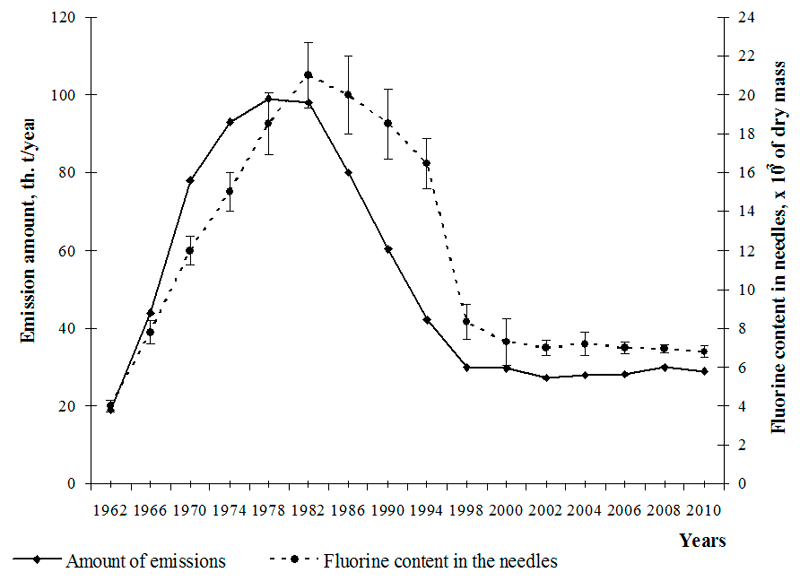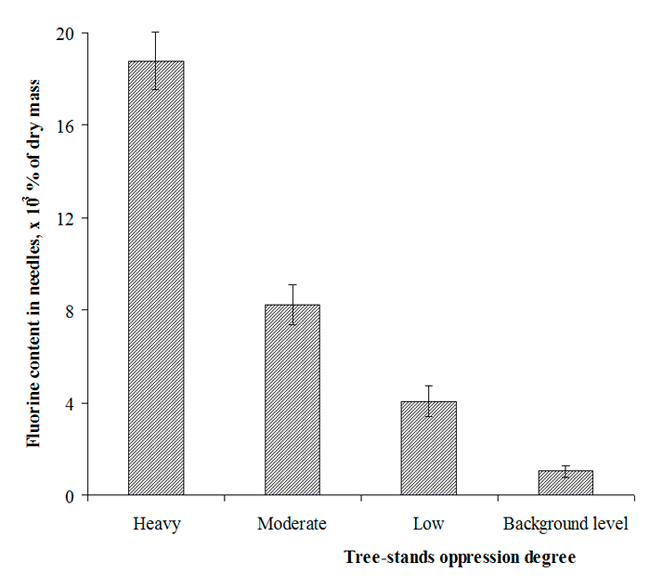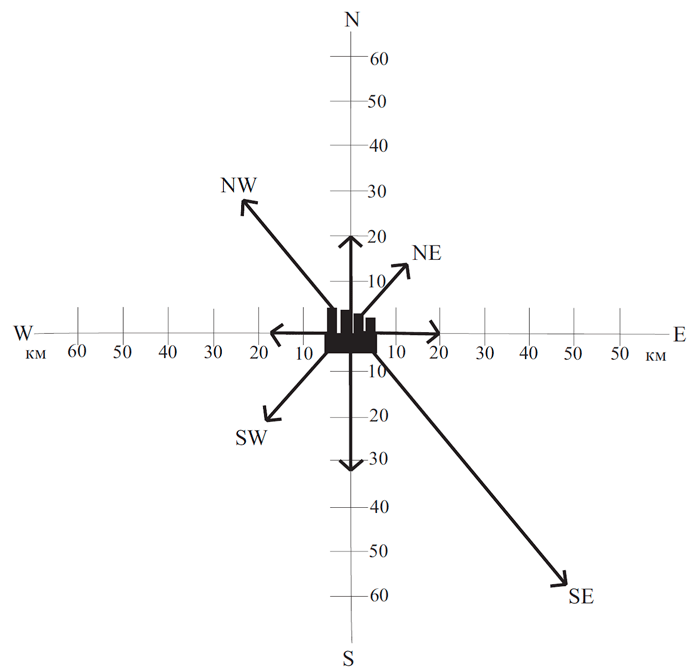Received: April, 2011
Fluorine Notes, 2011, 76, 5-6
PHYTOMONITORING OF TECHNOGENIC FLUORIDES IN BAIKAL REGION
T.A. Mikhailova , O.V. Kalugina , O.V. Shergina
Siberian Institute of Plant Physiology and Biochemistry Siberian Branch of the Russian Academy Sciences
Irkutsk, Russia
e-mail: mikh@sifibr.irk.ru
Abstract:The study demonstrated adequacy of using pine needles as a bio-indicator of fluorine-containing emissions in the environment. The results confirm that biological monitors, in particular, phytomonitors are advantageous in comparison with conventional methods of technogenic polluting agents monitoring.
Keywords:technogenic fluorine-containing emissions, phytomonitoring, Scots pine (Pinus sylvestris L.)
Currently study of the impact of fluorine technogenic compounds on the environment remains crucial with the number of powerful sources of fluorine-containing emissions (primarily aluminum plants) growing and, respectively, high level of fluorine pollution in some regions of the country. Establishment of large-scale concerns in aluminum industry resulted in the expansion of many industrial enterprises and construction of new plants. Two large-scale aluminum plants (Bratsk and Irkutsk) have been operating in the Baikal region for some decades, besides, new aluminum-producing facilities comparable in productivity with the existing ones are under construction in Taishet. State-of-the-art waste treatment equipment of these plants does not prevent intense pollution of the environment including forest ecosystems on vast territories.
Highly aggressive fluorides of aluminum plants emissions are dangerous for all live organisms with plants being most sensitive to them [1]. Phytotoxic impact of fluorine compounds is fairly well studied [2; 3]. For instance, hydrogen fluoride poisoning effect is known to be 3 – 3000 times stronger than the impact of other acidic gases (chlorine, sulfur dioxide, nitrogen oxides, carbon oxides) [3; 4]. Normal fluorine concentration in plants is very low, it does not exceed 3×10-3% of dry weight [5]. In conifers' assimilation organs its natural concentrations amount to 0.8-2.0×10-3% of dry weight [6; 7]. Tests with film gas chambers established that fluorine threshold concentration in needles with no visible damage (chloroses and necroses) for young pine, spruce, and larch trees amounts to 4-6×10-3% of dry weight, needles perish with fluorine content reaching 20×10-3 % [3].
High chemical activity of fluorine and its compounds facilitate their ability to penetrate from polluted media (air, soil) into all tree organs via leaves stomata and cuticle, trunk and branches bark, root system, and to accumulate there in considerable amounts. At the same time plants more actively absorb fluorides via aerial route – from the atmosphere. Fluorides introduction into plant organisms via roots takes place mostly in extremely polluted soils at the distance of 3-5 km from large technogenic sources of fluoride-containing exhaust [3; 8].
In plant organisms fluorides are subjected to weak detoxification, which makes them very toxic for plants [9]. Fluorides, in particular hydrogen fluoride, are also known to dramatically enhance toxic impact on plants in synergy with other polluting agents (sulfur dioxide, chlorine) [3].
Atmospheric pollution impact is particularly dangerous for conifers characterized by increased sensitivity to pollutants. We have shown that many Siberian coniferous species (larch, spruce, pine, Siberian cedar pine, fir, juniper) are by one order less resistant to hydrogen fluoride and sulfur dioxide at compared to deciduous species [7]. Conifers are believed to be close to moss and lichens by sensitivity to atmospheric pollutants. Consequently, the extent of weakening of coniferous forests may be used an indicator of hazard of the acting atmospheric pollution for live organisms as a whole; this proves significant of forest state evaluation as an indispensable aspect of human habitat indication. Results of such evaluation are to be taken into account while making decisions on the location of industrial facilities, new settlements and recreational areas, as well as on establishment of specially protected zones. Primary part of such evaluation is long-term monitoring of the most toxic and distributed polluting agents.
Conventional methods of technogenic pollutants monitoring have a number of restrictions. Direct monitoring of atmospheric air with the required network of sample collection and necessary time intervals is hard to implement for both technical and financial reasons, and results of snow cover monitoring reflect atmospheric pollution only in winter (100–120 days in a year). Modeling of the processes of spatial transmission of polluting agents from their sources in some cases does not provide adequate results correlating with the data of direct measurements. Under these circumstances application of biological monitors, in particular, phytomonitors, resolves the problem of collection of representative amount of air samples and makes it possible to define distribution of polluted air masses through the region on the basis of the study of pollutants impact on biological objects. Besides identification of boundaries of technogenic emission dispersion, monitors at the same time allow to evaluate negative pollution impact on biota.
Scots pine (Pinus sylvestris L.) was chosen as a biomonitor (bioindicator) of Baikal region forests pollution. This species, besides wide distribution, important forest-forming and economically important functions, is characterized by high sensitivity to anthropogenic influences, including atmospheric pollution [7]. Pine was selected as a biomonitor on the basis of the data on high degree of correlation between the level of atmospheric air pollution by fluorides and level of their accumulation in pine needles. Besides, the amount of accumulated toxic agent (fluorine) was shown to directly determine the degree of tree damage that is to facilitate identification of fluorine phytotoxic effect [10].
The territory polluted by Irkutsk aluminum plant (IAP) emissions was chosen as a testing area. Phytomonitoring of technogenic fluorides in this area was started virtually since the plant commencement [11; 12]. Fluorine accumulation (total content) in pine needles was determined by photometric method after distillation with vapor [13; 14]. The data on the amount of IAP atmospheric emissions were provided by official sources [15; 16].
Comparative analysis of the data acquired demonstrated correlation between dynamics of plant fluorine-containing emissions and the level of forest pollution assessed by fluorine accumulation in pine needles (Fig. 1).

Fig. 1. Dynamics of Irkutsk aluminum plant emissions and fluorine content in pine tree-stands needles.
As Fig. 1 shows, in the first 10-12 years after the plant commencement with emissions amount increasing fluorides gradually accumulated in tree tissues. In the next years with the drastic rise of emissions amount (maximum reached 100 thousand ton/year) fluorides accumulation in the needles and forest pollution also increased sharply. In mid 1980-s the scope of industrial emissions gradually went down, the same tendency was observed in respect of fluorine accumulation in tree needles. Since late 1990-s the polluted territory has been characterized by relatively stable amount of atmospheric emissions (29-30 thousand ton/year), this correlates with insignificant changes in fluoride content in pine needles.
It should be noted that in the middle of vegetation period (July) of 2009 some areas in the vicinity of the plant, mainly lowlands, demonstrated acute injuries of young pine trees. Judging by the character of injuries these trees (extremely quick yellowing of needles on young shoots), this situation was caused by bursting emissions of the aluminum plant. Measurement of fluorine concentration in injured needles proved it to be almost 10 times higher than background values. This fact once again proves adequacy of pine use as a bioindicator of fluorine-containing emissions in the environment.
Direct dependence of fluorides content in pine needles on the number of fluorine-containing components (hydrogen fluoride and solid fluorides) in the emissions is confirmed by calculation of correlation ratios for these parameters (Table).
Table. Correlation ratios between fluorides concentration in Irkutsk aluminum plant emissions and their accumulation in pine needles at difference distances from the plant (P = 0.05, n = 18)
Emission components |
Distance from the plant, km |
||
|
1-3 |
5-6 |
8-10 |
|
|
Total amount of fluorides |
0.89 |
0.84 |
0.74 |
|
Hydrogen fluoride |
0.93 |
0.89 |
0.88 |
|
Solid fluorides |
0.84 |
0.73 |
0.57 |
Study of coniferous forests adjacent to the plant monitored toxic effect of fluorine-containing emissions. The first 10-12 years after the plant commencement witnessed gradual weakening of the forests, which later showed visual signs – some local areas manifested extremely oppressed and dying trees. In the next few years the process of pine tree-stands oppression was characterized by high dynamics, forests damage attained critical level with maximum scope of emissions (100 thousand ton/year). In mid 1980-s the number of industrial emissions started to decrease gradually, and by 1996 it became 3 times as low. As mentioned above, the content of fluorides in tree needles also decreased, however, the state of damaged trees started to improve only in 10 years. Since the end of 1990-s up to these days the polluted territory has shown general trend towards improvement of tree-stands state; however, some areas (particularly wind-exposed slopes of highlands) demonstrate chronic oppression of moderate intensity, whereas percentage of heavily weakened tree-stands became minimal. Tree-stands of various oppression degree are characterized by a certain level of fluorine accumulation in needles (Fig. 2).

Fig. 2. Fluorides accumulation in pine needles at different degree of tree oppression
Research of spatial distribution of fluorine-containing emissions in the region established that fluorides pollution has no local character, it embraces a vast territory. This is due to the possibility of further atmospheric transfer of fluorine-containing emissions. We showed that fluorides are transferred from IAP for 15-60 km in various directions (Fig. 3). There is danger of industrial emissions distribution in south-eastern direction, as they may reach Lake Baikal shores.

Fig. 3. Distribution of fluorine-containing emissions from Irkutsk aluminum plant
Besides the territory adjacent to IAP there were identified other sectors of fluoride pollution. Thus, double or treble level of fluorides is identified in tree needles in the vicinity of Irkutsk, Angarsk, Usolye-Sibirskoye, Cheremkhovo. This proves that fluorides are emitted, although in small quantities, by a number of other producers including chemical plants and heat power-stations. The farther from the industrial centers fluorine content in pine needles gradually decreases, it is minimal in the territories, which are not subject to major atmospheric transfer of the emissions – in Pre-mountainous areas of Vostochny Sayan, Tunkinskaya valley, Goloustnaya and Lena rivers basins. These territories may be classed as background ones by fluorides content in pine needles.
Therefore, analysis of the data acquired proves pine needle to be an adequate test-object for phytomonitoring of atmospheric pollution by fluorides.
References
1. Ilkun G.M. Air pollutants and plants. Kiev: Naukova dumka, 1978. 247 p.
2. Nikolayevsky V.S. Biological
bases of plant gas-resistance. Novosibirsk: Siberian Division, 1979. 278 p.
3. Rozhkov A.S.,
Mikhailova T.A. Impact of fluorine-containing emissions on coniferous trees. Novosibirsk: Nauka.
Siberian Division, 1989. 159 p.
4. Weinstein L.H., Davison A.W. Native plant species suitable
as bioindicators and biomonitors for airborne fluoride // Environmental Pollution. 2003. V. 125.
P. 3-11.
5. Kabata-Pendias А., Pendias Х. Microelements in soils and plants. Moscow: Mir, 1989.
439 p.
6. Guderian R. Air pollution. Moscow: Mir, 1979. 200 p.
7. Rozhkov A.S., Mikhailova
T.A. The Effects of Fluorine-Containing Emissions on Conifers. Berlin Heidelberg: Springer-Verlag,
1993. 143 p.
8. Arnesen A.K.M., Abrahamsen G., Sandvik G., Krogstad T. Aluminium-smelters and
fluoride pollution of soil and soil solution in Norway // The Science of the Total Environment. 1995.
V. 163. P. 39-53.
9. Keller Th. Zur Beeinflussung des physiologishen Blattalters von Waldbaumen
durch Fluor-Immisionen // Ibid. 1976. B. 52. N. 2. S. 101-158.
10. Mikhailova T.A., Berezhnaya
N.S. Map of Physiological state of pine tree-stands in southern and middle parts of Baikal natural
territory // Geography and natural resources. 2003. №1. P. 56.
11. Rozhkov A.S., Pleshanov А.S.,
Massel G.I., Mikhailova T.A. Impact of natural and anthropogenic factors on Siberian coniferous forests
// Proceedings of the Siberian Branch Russian Academy Sciences. Series Biol. Sciences. 1989. V. I.
P. 136-139.
12. Mikhailova T.A., Berezhnaya N.S. Assessment of pine forests condition under long-term
impact of aluminum plant emissions // Geography and natural resources. 2000. N 1. P. 43-50.
13.
Kiseleva Е.К. Analysis of fluorine-containing compounds. М.; L.: Chemistry, 1966. 220 p.
14.
Guidelines for atmospheric pollution monitoring. L.: Gidrometeoizdat, 1979. 448 p.
15. State
report on the state and protection of natural environment of the Irkutsk region in 1995. Irkutsk:
Publ.house Oblmashinform, 1996. 131 p.
16. State report on the state and protection of natural
environment of the Irkutsk region in 2009. Irkutsk, 2010. 585 p.
Recommended for publication by Prof. S.M. Igoumnov
Fluorine Notes, 2011, 76, 5-6
